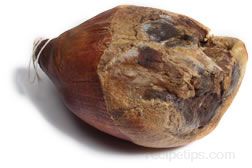 |
|
| Sometimes referred to as country hams, they are cuts from the hind leg of a hog that have been cured without the injection of water. A curing compound consisting of salt and other ingredients, which may include sugar, sodium nitrate, nitrates, phosphates, and other seasonings, is rubbed on the surface of the ham. The ham is then hung to dry, allowing it to age anywhere from a few weeks to over a year, depending on the variety of ham. Generally, the aging process is approximately six months. During this time the curing compound penetrates through the entire ham, drawing out moisture and thereby preserving the ham. The weight of the ham is reduced 18 to 25 percent. The loss of moisture produces a more intense flavor and deepens the color of the ham. Dry-cured hams may also be smoked. Ham that is dry cured is saltier and drier than the typical ham you find in normal food stores. Dry-cured country hams may be found in a market near the area in which they are produced but typically they have to be special ordered. There are also dry-cured hams available that are not country hams, such as prosciutto ham, which is a lightly salted dry-cured ham that is air-dried for many months and served raw. |
|
|

